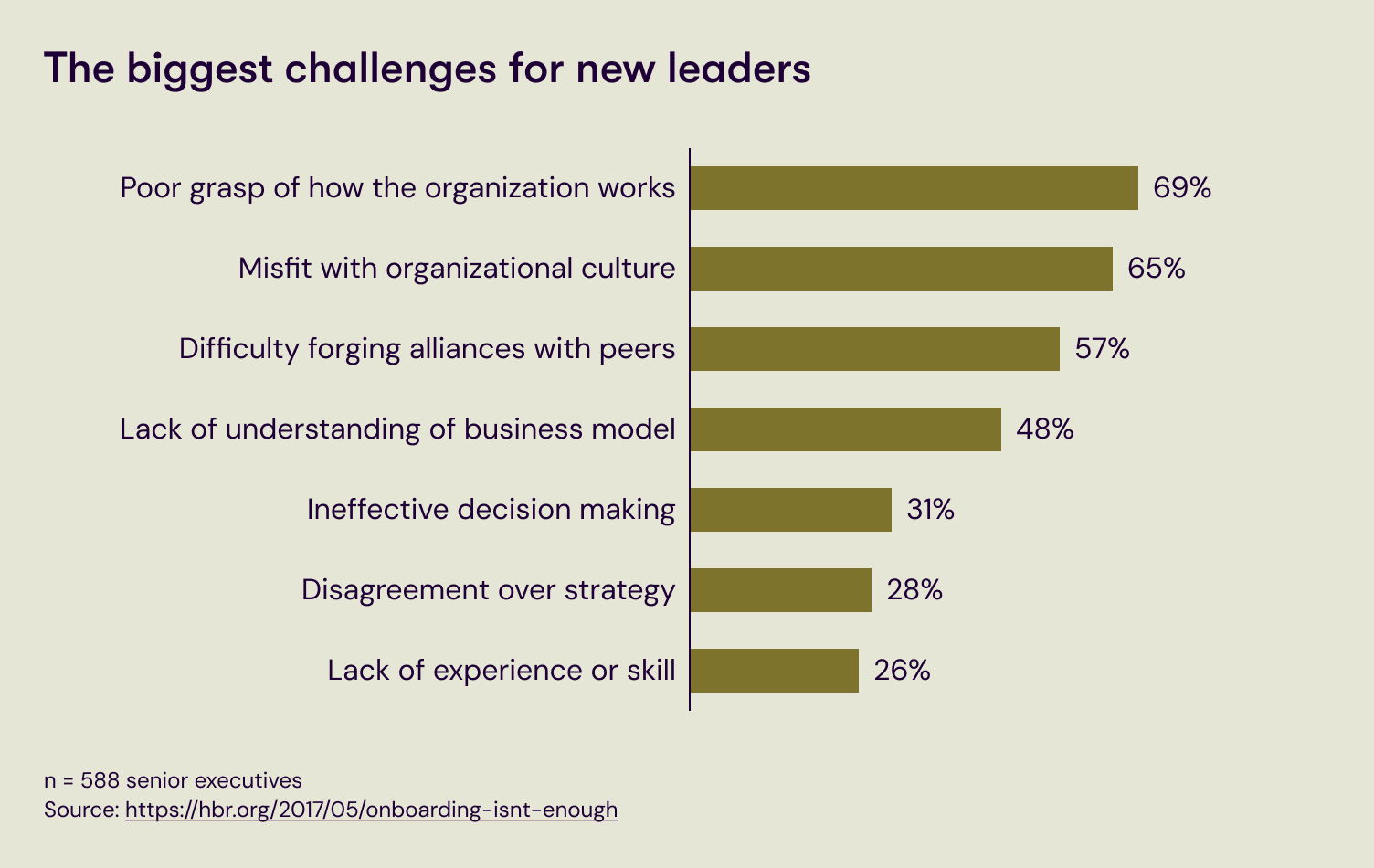Leadership and Executive onboarding: 5-step plan
In this article, we will define leadership onboarding, discuss potential challenges, provide a 5-step executive onboarding plan, and introduce the tools that can help you on your way.

Formal onboarding processes for new hires and staff transitioning between roles are vital to managing your workforce. Initial training and instruction on how to perform in a new role significantly determine an employee’s future success.
The importance of onboarding only increases when it comes to executive and leadership positions. With more information to take on, strategic decisions to make, and staff to oversee, executives have a more considerable influence on the organization.
Harvard Business Review research shows that impactful onboarding processes and support can reduce the average time new leaders take to reach full performance by a third, from six months to four.
Yet, a survey of VP-level executives and above found less than a third received this support when starting a new role. Of those that did, 80% stated it made a significant difference in them having an early impact.
So, how do you implement impactful executive onboarding programs tailored to your organization?
In this article, we will define leadership onboarding, discuss potential challenges, provide a 5-step executive onboarding checklist, and introduce the tools that can help you on your way.
- What is leadership onboarding?
- The most common challenges impacting new leaders during onboarding
- 5 steps for effective leadership and executive onboarding plan
- Tools for leadership onboarding
What is leadership onboarding?
However, due to the unique needs of staff in management roles and above, leadership onboarding must go beyond typical employee orientation programs.
The impact of leadership onboarding is more significant, and the process is more complex, with more information to deliver and a greater depth of knowledge about the company required.
Therefore, organizations require tailored executive onboarding plans that consider their greater responsibilities.
Components of leadership onboarding
Typical components to consider include:
- Stakeholder introductions: meeting and starting relationships with the business’s most important internal and external stakeholders, such as board members, investors, and major customers.
- Operational review: getting to know the organization, its strengths and weaknesses, its workflows and structure, and how the new leader fits into it.
- Strategic alignment: undergoing in-depth sessions with senior leadership to comprehensively understand the company’s long-term vision and strategic goals.
- Cultural assimilation: helps with understanding and integrating into the working culture of the organization as well as its approach to leadership and delegation.
- Team integration: meeting with their direct reports to determine how they like to work and communicate before developing plans for any changes the new hire wants to implement.
- Financial review: a detailed understanding of financials and how their performance and that of their team/department affects the company’s bottom line.
An ad-hoc approach to leadership onboarding, where hires are left to work things out for themselves, introduces too much risk to an already high-stakes appointment.
While some executives may become a success, quickly grasping their new working situation and fitting in, many others will falter.
Read the story of retail company MadeiraMadeira who achieved 99% new manager onboarding completion rate.
Read our recent blog: How to onboard a new customer in 10 steps

Employee onboarding checklist in PDF and Excel formats
Ensure a smooth and effective onboarding process for your new leaders and set them up for success.
DownloadThe most common challenges impacting new leaders during onboarding
You still face many challenges, even with a formal leadership onboarding program. New leaders inherently lead to new outcomes, and there are many ways in which hires can be a poor fit for your organization.
A survey of HR practitioners and employees found the most prevalent challenges during employee onboarding to be:
- Communicating job duty and expectations (66%)
- A lack of clarity (64%)
- Workstation setup and technology access (56%)
Interestingly, the survey highlighted differences in opinions between employees and HR.
For example, only 29% of companies believe there is a lack of clarity in their onboarding processes compared to 64% of employees.
Additionally, there is a disconnect between employees and HR staff when navigating the new company’s culture.
Only 37% of employees reported difficulties, but 61% of HR staff stated it was a critical onboarding challenge.
This shows that companies overestimate the quality of their onboarding practices, and employees underestimate the challenge of fitting into the new company’s culture.
Going back to HBR’s research, after surveying 588 senior executives who recently transitioned roles, they found the biggest challenges for new leaders to be:

Even the most qualified and talented employees go to waste if they are not correctly integrated into the organization and given adequate support.
Organizations need to develop an executive onboarding checklist and best practices that consider each challenge.
Leadership onboarding plan: 5 steps for effective leadership onboarding
Below is a leadership onboarding plan to develop a practical framework for your organization to adopt.
Each step covers a set timeframe with key actions to perform. By ticking off the executive onboarding checklist for each, you’ll increase the likelihood of executives making a great start at your organization.
However, the best leadership onboarding programs tailor to the organization, role, and candidate. Every situation is different, and you should adapt this generalized plan to fit your needs.
Note: If you want to have more detailed employee onboarding checklist you can check it here, it is also applicable for leadership onboarding.
Step 1. Pre-boarding – getting prepared
Onboarding starts before the first day on the job. You need to work closely with new executive hires to prepare for their start date.
This includes administrative tasks such as completing paperwork, providing introduction packages, and setting up IT access. However, it also includes introducing the company culture and describing how they will fit into it.
Cultural fit determines whether or not they will be successful within your organization and if they reflect your core values and behaviors. It should be a key factor during the interview process.
Preparing an organizational briefing is a fundamental part of pre-boarding. New leaders need extensive details on their roles and responsibilities to understand what expectations from day one.
Next, they need to know how this role fits into the company’s cultural norms and organizational structure. You should also provide contact information for key stakeholders and staff members they need to know.
This could include detailed information on:
- The company’s core principles and goals.
- Organizational structures and communication channels.
- Performance management tools used at the organization.
- Current leadership styles – how the wider corporate culture informs it, how leaders delegate and communicate with their team, and how to perform conflict resolution in the workplace.
The process of developing and organizing training content can be significantly improved using a dedicated Learning Management System (LMS) such as Valamis.
With tools for content generation and the ability to implement tailored learning paths for executives and leaders, LMS helps simplify onboarding and increase productivity from day one.

An overview of the Valamis Learning Management Platform that can make leadership onboarding easier and smoother.
Pre-boarding checklist:
- Administrative/logistical needs: Ensuring you have all the information prepared and all the paperwork is complete, preparing the workstation and tools they need, as well as system access.
- Clarify role and expectations: Define their responsibilities, objectives (both long and short-term), and metrics used to assess staff and business performance.
- Prepare cultural and organizational briefing: Share an organizational chart and explain the company’s structure. Provide insights into the company’s mission, values, culture, and any unwritten rules.
- Contact information: Provide contact details and schedule introductions with key stakeholders, the HR department, and direct reports.
- Organizing and developing training content: Gather all the necessary material for the new hire and consider generating specific resources for leaders. This process can be improved using dedicated L&D tools.
Step 2. Day one – introduction
Day one can feel like a blur, rushing to make introductions and teach the hire everything they need to know.
However, it is essential to remember that this is only the start of a process that takes several months. You can’t build out the entire working relationship in a single day. You just need to lay the foundations for success.
Day one checklist:
- Welcome and orientation: Welcome the new executive to the team.
- Introduce the business and culture: Provide a high-level overview of the company and how it operates.
- Meet stakeholders: Meetings with the leadership team, direct reports, and other key internal and external stakeholders.
- Logistics review: Confirm access to the necessary systems and tools.

Employee onboarding learning path inside Valamis learning environment.
Step 3. Month one – information gathering
During the first month of leadership onboarding, the main goals should be providing all of the information and training content the new hire needs, relationship building, and gathering the knowledge required to develop future plans.
Month one checklist:
- Deep dive into the business: Observe operations and meet with department heads to understand their purpose and structure.
- Identify challenges and opportunities: Ask the hire to assess their team, workflows, and resources to start developing strategies for how they want to lead long-term.
- Develop relationships: Start implementing the day-to-day relationships and routines they need to do the job.
- Create a longer-term plan: Develop a plan for the next month, including looking for opportunities to get quick wins for the leader as they become more settled. Ream more about leadership development plan.
- Introduce the learning environment: Ensure they have access to all the necessary training content and can quickly start their learning path.
- Complete mandatory training: Provide training courses and resources related to compliance and workplace rules.
Step 4. Month two – strategy development
Once the executive has spent some time working with their team, they can start to develop a strategy for how they are going to lead.
Month two checklist:
- Begin strategic initiatives: Help them implement their leadership style and strategic plan. Establish goals and performance expectations for the leader based on their strategy and the organization’s long-term objectives.
- Stakeholder communication: Begin regular meetings with the new hire, the leadership team, and other key stakeholders.
- Onboarding review: Conduct an early leadership onboarding review to assess the new hire’s progress.
- Get an early win: Identify a task to give the new leader an easy win and help build momentum.
Step 5. Long term – full integration
With a strategy in place, the leadership onboarding program can start working towards full integration in month three and beyond.
Longer term checklist:
- Measure progress: Review how the new leader is integrating into the organization and assess any initial results and successes.
- Evaluate team performance: Link the new hire’s individual performance with the broader team they oversee.
- Refine longer-term strategy: Develop a 6- or 12-month strategic plan for how they want to develop their team moving forward.
- Lead significant initiatives: Allow the leader to take ownership of large-scale, key projects within the organization.
Tools for leadership onboarding
With a lot to cover during leadership onboarding, organizations need various tools to help deliver successful programs.
Surveys of HR practitioners show the main reasons for using technology during onboarding are:
- Empowering employees to manage their own onboarding experience (52%)
- Reducing the time and effort required (38%)
- Creating effective communication (28%)
- Removing paperwork (27%)
- Providing digital training (21%)
- Gathering metrics for greater efficiency (15%)
All these and more are achievable using the Valamis platform – a comprehensive LMS that can adapt to your specific executive onboarding program.
With Valamis, executives can manage their onboarding process from a single interface, accessing all the necessary resources and training. Organizations can design and implement bespoke executive onboarding programs to track goals and measure success.
But don’t take our word for it.
Check out a recent case study where 360 new leaders were successfully onboarded using the Valamis platform. The introduction of Valamis increased training content production by 210%, and 99% of new managers completed asynchronous onboarding via the platform.

Employee onboarding checklist in PDF and Excel formats
Ensure a smooth and effective onboarding process for your new leaders and set them up for success.
Download



